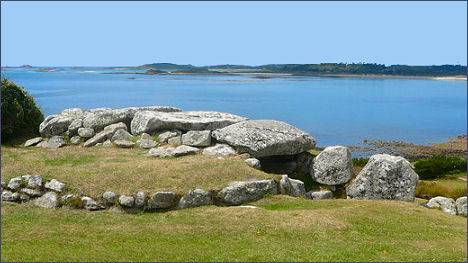Bant's Carn
OS grid reference :-SV 910 123
 Bant's Carn, an entrance grave dating from the Bronze Age lies in a highly scenic location on the island of St. Mary's.
Bant's Carn, an entrance grave dating from the Bronze Age lies in a highly scenic location on the island of St. Mary's.
There is evidence of extensive settlement on the Isles of Scilly from around 2500 BC. At that time the sea level was lower and much of the Scilly Islands formed a single landmass.
The tomb measures about 8 metres (26 feet) in diameter and stands on a low platform 12 metres (39 feet) across.
The boat-shaped, stone-lined internal chamber itself measures around 5 metres (16 feet) in length and 1.5 metres (4.9 feet) in width and height, four large capstones serve as a roof.
Bant's Carn was excavated in 1900 by George Edward Bonsor Saint Martin, who found the remains of four cremations at the rear of the chamber, along with sherds of Neolithic and Bronze Age pottery. More pottery of a similar kind was discovered in 1970 during the re-erection of a fallen capstone.
The site also includes remains of post-medieval field systems and other occupation. It, together with the nearby late Iron Age/Romano-British village of Halangy Down is now in the care of English Heritage.
Directions
The site can be accessed from a track leading off the B road by the Telegraph Tower, or by taking the coastal path from Hugh Town or Porthloo